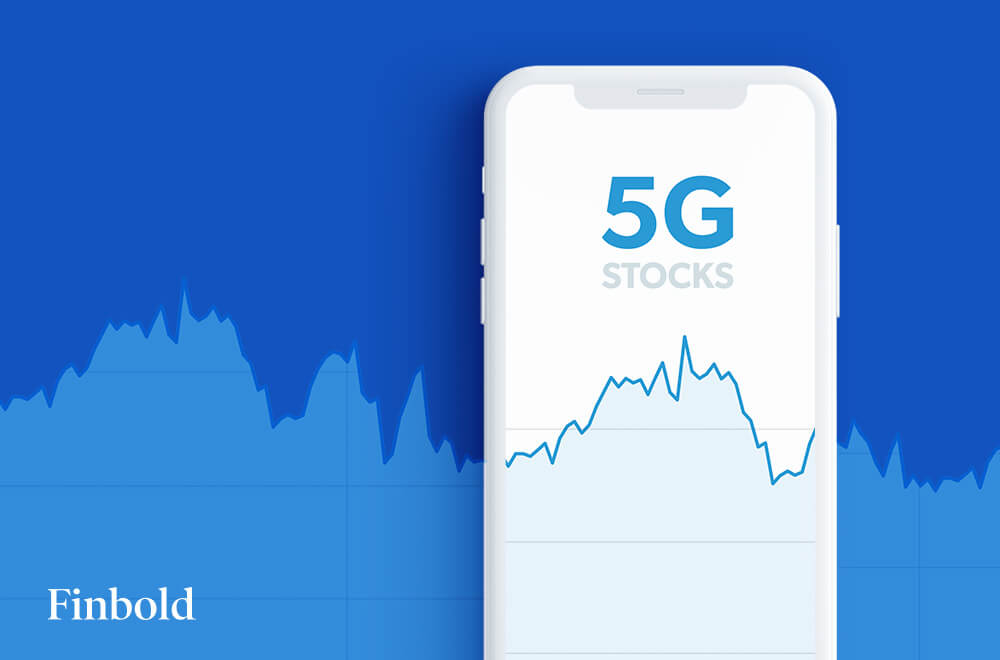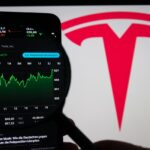[robinhood]
As the preparation for the full launch of the network progresses, the stocks may hold value in the near future. In this article, we will reveal our top 10 picks of the best 5G stocks to buy in 2022.
About 5G technology
Before diving into the top ten 5G stocks list, let us explain to you the basics of the 5G network and what you should know about this emerging technology.
Communication technology has grown significantly since the inception of mobile communication devices. There are currently 4 generations of wireless communications technologies supporting cellular data networks. These are 1G, 2G, 3G, and 4G, which was the latest and fastest until the 5G network was launched.
5G is the 5th generation wireless communication technology that is one hundred times (x100) faster than 4G, and the new infrastructure, such as higher frequency antennas are already being built.
The advantages of this network include increased speed, lower latency, and therefore greater capacity for remote execution. Additionally, more devices can be connected with the potential for implementing virtual networks (network slicing). The lower latency means huge files or websites that require a lot of time to load will be able to load at a fraction of the time. With a 5G network, mobile applications can be executed from the cloud instead of having to install such apps or other files on mobile devices, thus saving space.
The technology also has the potential to favor the Internet of Things (IoT) as it allows the connection of up to millions of devices per square kilometer with instant access to the internet and real-time sharing of data. This is what will drive the building of smart cities in which autonomous cars can be operated and better surveillance can be carried out with camera devices fixed in strategic parts of such cities.
In spite of the seemingly great advantages that the 5G network has, there are concerns raised by individuals and groups, which have been strongly debated. For instance, some have connected the COVID-19 pandemic to 5G technology as its origin and may be responsible for weakening the immune system in humans.
Apart from the health concerns surrounding 5G, it is said to have negative impacts on vulnerable areas of the environment. Some researchers argue that as several devices can be connected to the network, the huge energy use can eventually contribute to global warming. There are also security concerns on the 5G network as a massive DDoS attack could easily be deployed against the network with many devices connected.
However, researchers in technology and radiation studies have expressed that the 5G does not have the capacity to cause any of the damages that it is said to cause. This is because 5G radiation is non-ionizing and does not have the kind of energy required to penetrate the human body or cause any damage to the genetic structure. As a result, it is impossible for the radiation to produce cancer or any of the other health problems highlighted.
5G industry projections
Despite the growing controversy around 5G, there are financial opportunities for investors with the new technology.
The 5G technology market is expected to surpass $700 billion by 2025 owing to a projected Compound Annual Growth Rate (CAGR) of 70.83% CAGR. Additionally North America is set to dominate the global 5G market with a CAGR of 71%. In the long run, it is projected that the industry will contribute $13.2 trillion to the global economy and support 22.3 million jobs by 2035.
Though relatively new, it is one of the fastest-growing technology and has registered its presence in the global financial market. Stocks from different 5G companies have now gone live on 24 markets and the GSM Association (GSMA) projects that it will be 20% of global connections by 2025. The GSMA also predicts billions more IoT devices will be coming on stream over the next five years and that between 2019 and 2025, the number of global IoT connections will more than double to almost 25 billion.
According to a GSA report, in June 2021, 58 nations had 5G networks, up from 38 a year before. The cities have varying levels of deployment with some having full deployment while others have partial deployment and more are expected to be covered. Ericsson, a Swedish telecom company projects that the network will cover 65% of the world’s population by 2025.
Additionally, our previous report has revealed that the global adoption of the 5G network is set to skyrocket in the next five years. The data compiled by Finbold.com estimates that by 2025, the number of 5G connections is expected to hit 2.7 billion worldwide, a growth of at least twenty times from this year’s figure of 120 million.
Also, it is projected that 60% of the global population will have 5G access by 2026.
With such a promising future for the technology, its potential as an investment can hardly be debated. There are currently several 5G companies with stocks that are potentially profitable for investors in the long run. [robinhood]
Ten 5G Stocks that have potential
Apple Inc. (NASDAQ: AAPL)
Market Cap: $2.4 trillion
Apple Inc. (NASDAQ: AAPL) is one of the largest technology manufacturers in the world. Apple designs, manufactures, and markets a variety of tech products including smartphones, computers, laptops, tablets, wearables, and accessories, as well as offering a variety of services and digital products.

Apple is most notable for the iPhone product line but also offers Apple TV, Beats products, iCloud, Apple Arcade, and a co-branded credit card, Apple Card. In addition to offering products and services, Apple also markets third-party applications through the App Store, Mac App Store, and WatchApp Store.
As an international market leader, Apple possesses a retail footprint that spans across 25 regions and countries, with over 500 stories. In addition to the 270+ Apple stores located in the United States, Apple also maintains retail 240 locations in Australia, Europe, Canada, China, Hong Kong, Japan, Singapore, South Korea, and Mexico.
The global manufacturing and assembly supply chain owned by the organization is networked across the globe, with components and products manufactured in Japan, the United States, Korea, India, and Taiwan
The smartphone arm of the company has rolled out a new series of 5G iPhone products, an event that is likely to significantly impact the 5G stocks ecosystem in 2021.
Apple iPhone sales beat consensus at the end of Q1 2020, approaching $56 billion. Stock buybacks and dividends of over $24 billion assisted in a 40 percent AAPL stock gain since September 2019 — combined with the launch of new services and wearable products, the launch of Apple’s iPhone 13 models with the latest 5G could potentially push Apple’s current market cap up to $3 trillion by the end of 2021.
Apple’s iPhone 13 models have driven up demand for 5G modems that support mmWave. According to reports, Apple is set to provide an enormous 5G performance increase for iPhone 13 users globally after restricting top-tier 5G performance to US-released iPhone 12 Pros.
mmWave is faster than conventional 5G, and while standard 5G provides a significant improvement over 4G, the two can sometimes be quite similar. mmWave, on the other hand, can achieve rates of up to 3Gbps (3000Mbps), with some experiments exceeding 4Gbps.
Apple’s 5G licensing plans for the next four years were detailed in a settlement file with Qualcomm late last year. It specifically specifies that mmWave-compatible “Apple Products” (i.e., iPhones) in 2021 will employ Qualcomm’s X60 5G modem, saving space, reducing battery drain, and lowering costs.
Apple currently has a market cap of $2.4 trillion — analyst insight into AAPL stocks presents a 12-month price forecast with a median target of $162, with a high estimate of $185 and a low estimate of $90. The median $162 estimate represents a 7 percent increase over mid-2021 prices.

QUALCOMM, Inc. (NASDAQ: QCOM)
Market cap: $166.04 billion
QUALCOMM, Inc. (NASDAQ: QCOM) is a US-based multinational semiconductor and telecommunications equipment manufacturer. Qualcomm develops, manufactures, and distributes digital wireless communications products and services around the world, making it a strong contender as one of the most interesting 5G stocks of 2021.

The international semiconductor manufacturer operates through several segments, which include Qualcomm CDMA Technologies (QCT), Qualcomm Technology Licensing (QTL), and Qualcomm Strategic Initiatives (QSI). Each segment operates in various verticals — the QCT segment is primarily concerned with the development of integrated circuits and system software for use in data and voice communications, as well as GPS products.
With few competitors, QCOM is currently the leading supplier of microprocessors in the China region, and is set to supply chips for the new series of Apple 5G iphones. The company also plans to develop and distribute a variety of 5G development platforms, such as new artificial intelligence enabled robotics products with a focus on 5G connectivity.
Qualcomm sales increased by 63 percent compared to the same period last year, while profits per share more than doubled year over year in the fiscal quarter that ended on June 27. The chipmaker announced third-quarter results that surpassed analyst expectations and provided a positive outlook for the fourth quarter.
Strictly speaking, Qualcomm Technology Licensing, which includes income from 5G patents and other smartphone technology, increased 43 percent to $1.49 billion.
Furthermore, Qualcomm’s QCT semiconductor division generated $6.47 billion in revenue, a 70% rise year over year. However, the fastest-growing QCT category was RF front-end, which increased 114 percent year on year to $957 million in sales. RF front-end chips are a critical component of 5G.
Qualcomm is a strongly positioned supplier, supported by offerings that span baseband, transceiver, radio frequency, front-end products, and antenna. The launch of 5G is set to support an expansion of the addressable market available to Qualcomm.
With new questions on consumer spending amidst the ongoing COVID-19 pandemic, carriers are highly incentivized to drive contract upgrades that focus on 5G integration. Qualcomm currently holds best-in-class modern technology to the communications industry, and is positioned to capitalize on the first major communications upgrade cycle in nearly a decade.
Qualcomm currently has a market cap of $166.04 billion. Expert analysis indicates a 12 month price forecast of $184, with a high estimate of $225 and a low estimate of $148. The median $184 estimate represents a 27 percent increase over mid-2021 prices.

Broadcom (NASDAQ: AVGO)
Market cap: $195.22 billion

Broadcom (NASDAQ: AVGO) is one of the largest semiconductor manufacturing businesses in the world and currently sits in third place globally after Intel and Qualcomm. Broadcom manufactures a broad spectrum of communications technology and semiconductor products including ethernet controllers, network switches, and wireless APs.
Based in the United States, Broadcom owns valuable intellectual property that it licenses to other organizations. Intellectual property and products manufactured by IP are distributed across a wide range of verticals and are used in private broadband connections, smartphones, telecommunications equipment, energy systems, factory automation, and consumer electronics.
Broadcom is currently benefitting from the 2021 5G upgrade cycle — the semiconductors Broadcom manufactures are a critical component for new 5G network deployment.
The ongoing COVID-19 pandemic has not affected Broadcom in a significant way — the company has maintained strong operations, increasing revenues by 4 percent year over year and reporting a record cash flow in excess of $3 billion — a 205 percent improvement from year-to-date numbers.
In February 2020, Broadcom announced the completion of a new 5G switching portfolio designed to deliver a feature set that meets new 5G technology standards. In March, Broadcom was highlighted by Forbes as a market leader in 5G infrastructure — in June, Broadcom was announced as the supplier of 5G chips for the new Nokia ReefShark product line.
In response to the growing demand for semiconductors, Broadcom has stepped up its game. Q2 revenue for the chipmaker increased by 15 percent year over year to $6.6 billion, while adjusted earnings per share jumped from $5.14 per share in the prior-year period to $6.62 per share for fiscal 2021 Q2.
Samsung and Apple are using Broadcom chips in their 5G smartphones, so the wireless segment appears to be able to maintain its high levels of growth going forward. A $15 billion deal between Apple and Broadcom to purchase smartphone chips in the second half of 2023 has made Apple one of Broadcom’s most important customers.
As a result of Broadcom’s supplier relationship with Apple and Samsung, the company is well-positioned to benefit from the fast growth of the 5G smartphone market. Due to exponential growth in the 5G smartphone market, Broadcom could become a top 5G stock in the future, especially when you consider its low valuation and high dividend yield.
Broadcom currently has a market cap of $195.22 Billion. Expert analysis predicts a 12-month price target of $543, with a high estimate of $400 and a low estimate of $305. The median $543 estimate represents a 13 percent increase over mid-2021 prices.

Skyworks Solutions Inc (NASDAQ: SWKS)
Market cap: $29.35 billion
Skyworks Solutions Inc (NASDAQ: SWKS), like many of the other stocks in this 5G roundup, is a manufacturer of tech solutions critical to the future of the 5G industry. Skyworks Solutions manufactures radio frequency chips that are used in mobile, wireless infrastructure, home automation, automotive, and industrial applications.

Notably, the company is closely linked to AAPL, and generated over 50 percent of its revenue from Apple alone in 2019, linking it closely to its price movement. Skyworks Solutions has rallied over 30 percent in the last five years, but experienced a significant slowdown in the 2017-2018 period due to a loss of orders from Huawei subsequent to the US blacklist of the telecommunications device provider in the US.
2019 saw the international chip manufacturer recover swiftly, offsetting the loss of nearly 10 percent of all sales due to the Huawei blacklist with stronger sales of analog chips for non-smartphone applications and the sale of products designed for IoT applications.
The research and manufacturing arms of SWKS are currently executing extensive research and development of new chips to power 5G connectivity for the next generation of smartphones alongside 5G infrastructure and powerful WiFi 6 technology for a range of consumer devices.
Importantly, Skyworks Solutions maintains a zero debt balance, with short term investments held by the company valued at $1.1 billion at the close of March 2020. Beyond 5G technology, Skyworks Solutions also distributed industrial equipment and smart devices, which account for roughly 30 percent of all sales as of Q2 2020.
Skyworks Solutions currently has a market cap of $29.35 billion. Expert forecast predicts a 12-month price target of $228, with a high estimate of $380 and a low estimate of $182. The median estimate for Skyworks Solution would represent a 27.84 percent increase from mid-2021 prices.

Intel Corporation (NASDAQ: INTC)
Market cap: $213.94 billion
Intel Corporation (NASDAQ: INTC) is one of the largest tech giants in the world, and currently holds a highly secure position focused on dominating future 5G tech markets. Intel has executed and published significant market research on the future of the 5G industry, predicting that over the next decade tech providers and media platforms will compete to capture over $3 trillion in wireless revenue opportunities facilitated by 5G networks.

In February 2020, Intel announced a new line of chips targeting 5G network infrastructure. The new Atom P5900 10nm system on a chip designed for wireless base stations is designed to dominate the base station sector, with Intel aiming to capture the position of the leading silicon provider for 5G base stations in 2021.
The new chip is positioned to target high bandwidth, low-latency base stations — Inten expects a target market of over 6 million new 5G base stations though to 2024. In addition to the new Atom chip, Intel is set to launch a new generation of Xeon scalable processors that are anticipated to transform the virtualized network market, delivering a growth rate of 80 percent.
Intel has already demonstrated a 40 percent increase in size since 2014, scaling revenue from $1 billion to $4 billion in 2019. The upcoming global rollout of 5G is expected to increase demand for cloud-based network services, of which Intel is currently a market leader.
To date, Intel has secured two large telecom equipment manufacturers with new tech designed to increase the efficiency of 5G base stations, anticipating a 40 percent market share by 2022 — placing Intel in a strong position as a transformative market leader in the upcoming 5G evolution.
Intel Corporation currently has a market cap of $213.94 billion. Expert price analysis places a 12-month median price target at $61, with a high prediction of $85 and a low estimate of $40. The average estimate for Intel would represent a 15.77 percent increase from mid-2021 prices.

CEVA (NASDAQ: CEVA)
Market Cap: $1 billion
Ceva (NASDAQ: CEVA) has grown to become one of the top stocks in the 5G technology sector. The company behind it, Ceva Inc is a U.S-based technology company that specializes in semiconductors. It serves as a licensing company for signal processing platforms and artificial intelligence processors for semiconductor companies and original equipment manufacturers (OEMs) serving the mobile, consumer, automotive, industrial, and Internet-of-Things (IoT) markets worldwide.

Formerly known as ParthusCeva, Inc., it also offers licenses to signal processing intellectual properties (IPs), including platforms for 5G baseband processing. This covers signal processing for handsets and base station RAN including integrated cellular IoT solutions; digital signal processor (DSP) platforms incorporating voice input algorithms and software for voice enabled devices and a host of others.
Its services also include provision of internet protocols (IPs) for Bluetooth and Wi-Fi platforms worldwide. It licenses its technologies to companies that design, manufacture, market, and sell application-specific integrated circuits and application-specific standard products to wireless, consumer electronics, and automotive companies for incorporation into various end products. Its technologies are licensed via direct sales force.
The company recently won the CEM Editor’s Choice Award for its Bluetooth 5 IP which was selected as the most competitive IoT solution in China. Also early this month, the Ceva announced its first high performance Sensor DSP Hub, SensePro, a family that serves as hub for processing and fusing of data from multiple sensors including camera, Radar, LiDAR, Time-of-Flight, microphones and inertial measurement units.
According to the analysts, 12-month price targets for Ceva are $60 (high forecast) and $50 (low forecast) with an average price target of $44. The average estimate for ceva would represent a 28 percent increase from mid-2021 prices.

Verizon Communications Inc. (NYSE: VZ)
Market Cap: $231.42 Billion
Verizon Communications Inc. (NYSE: VZ) has set itself apart as one of the top companies in the 5G industry and its stock is one of the leading ones with a promising future. First founded in 1983 as Bell Atlantic Corporation, its name was changed to Verizon Communications Inc. in June 2000. Its clients include consumers, businesses, and governmental entities to whom it offers communications, information, and entertainment products and services worldwide.

Consumers patronise services such as postpaid and prepaid service plans, Internet access on notebook computers and tablets, mobile devices, and other wireless-enabled connected devices such as smart watches and other wearables.
Verizon Communications also provides internet connectivity, video, and voice services for homes as well as virtual networks to mobile virtual network operators. As at the end of 2019, it had about 95 million wireless retail connections, 6 million broadband connections, and 4 million Fios video connections.
Its business segment provides network connectivity products, including private networking, private cloud connectivity, virtual and software defined networking, and Internet access services; and Internet protocol-based voice services, unified communications and collaboration tools, and customer contact center solutions.
It also offers a range of management and data security services; domestic and global voice and data solutions, including voice calling, messaging services, conferencing, contact center solutions, and private line and data access networks; customer premises equipment; installation, maintenance, and site services; and IoT products and services.
As at 31 December 2019, the segment had 25 million wireless retail postpaid connections and 489 thousand broadband connections and is expanding its reach with a strategic partnership with HERE Technologies and Dignitas as well as with Emory Healthcare to develop and test 5G Ultra Wideband-enabled use cases.
The company recently acquired enterprise-grade video conferencing and event platform Bluejeans to expand its immersive unified communications portfolio, making the stocks to have a brighter future. Verizon ended 2019 with the highest Q4 with the highest wireless adds, increased cash flow, and revenue growth in 6 years.
Second-quarter 2021 Verizon operational sales were $33.8 billion, up 10.9 percent from the second quarter of 2020 and up 5.3 percent from the second-quarter 2019 figures.
VZ stock is expected to hit $61.80 on average based on its 12-month price projection with a high of $68.00 and a low of $50.00. Accordingly, most experts think Verizon to be a strong buy, with an average price target rise of 10% from its mid 2021 price.

Nvidia Corporation (NASDAQ: NVDA)
Market Cap: $481.27 billion
Nvidia Corporation (NASDAQ: NVDA) is an American global technology corporation located in Santa Clara, California. It creates graphics processing units (GPUs) for gaming and professional sectors, while for mobile computing and the automotive industry, it designs system on-chip units (SoCs).

Network performance is boosted by the convergence of 5G, the internet of things (IoT), and edge computing. In order to keep up with the need for more memory and processing power, the world’s top telecommunications companies are turning to Nvidia’s technology to build a software-defined infrastructure capable of delivering intelligent services.
One of the biggest purchases in semiconductor history, the proposed $40 billion purchase of the U.K.-based chip manufacturer Arm, is in the works. If completed, it will be hailed as yet another milestone in Nvidia’s drive toward artificial intelligence (AI) and IoT.
Nvidia announced record revenue for the first quarter of 2021 to May 2021, with a year-over-year increase of 84 percent and a quarter-over-quarter increase of 13 percent. Furthermore, the business brought in $5.66 billion in sales, with the Gaming, Data Center, and Professional Visualization platforms bringing in new highs.
Over the next decade, there will be a convergence of three key secular trends: artificial intelligence augmented reality, and 5G, all of which will place growing demands on computing power and Nvidia’s value.
Nvidia has a market capitalization of $481.27 billion; expert forecasts for Nvidia stocks show a 12-month price target of $212, with a high estimate of $250 and a low estimate of $150. The median $162 prediction indicates a 9% rise above prices in mid-2021.

Comcast Corp (CMCSA:NASDAQ)
Market Cap: $272.86 billion
Comcast Corporation (CMCSA:NASDAQ), based in Philadelphia, is an American telecommunications giant. Comcast Cable and NBCUniversal are the two primary operations of the corporation, which is a global media and technology conglomerate. Under the XFINITY brand, Comcast Cable is one of the leading television, high-speed Internet, and phone providers in the United States, providing these services to businesses.

Comcast has expanded its mobile virtual network operator (MVNO) deal with Verizon. It is taking additional efforts to retain wireless as a significant element of its corporate strategy, including “leaning into 5G.”
Whatsmore, Comcast Business launched Comcast Business Mobile in July across the company’s footprint. Flexible data options, countrywide 5G coverage, and discounts make Comcast Business Mobile ideal for small businesses.
Moreover, Samsung introduced the highly anticipated Galaxy Z Fold3 5G and Galaxy Z Flip3 5G at Samsung Unpacked in August. Also, Comcast confirmed that Xfinity Mobile would be carrying both devices on its network.
Comcast reported a net income of $3.7 billion on revenue of $28.5 billion in July. As a result of exceeding profits forecasts, it grew by more than 20 percent compared to the prior year. With 380,000 new customers added, the company’s total customer relationships reached 33.5 million for the first time.
Additionally, 461 000 new users have signed up for high-speed internet service through the company. Due to repeated European lockdowns, Comcast’s Sky subsidiary added 221,000 customers in the first quarter, giving it its highest first-quarter performance in six years.
Comcast has a market capitalization of $272.86 billion; analysts’ estimates for Comcast stock show a 12-month price target of $66, with a high estimate of $72 and a low estimate of $59. The average $66 prediction indicates a 12% rise above prices in mid-2021.

MACOM Technology Solutions Holdings, Inc. (NASDAQ: MTSI)
Market Cap: $3.94 billion
MACOM Technology Solutions Holdings, Inc. (NASDAQ: MTSI) is another technology company based in the United States. It specializes in semiconductor devices and components and was the largest private employer in the United States in 2005.

It currently has design centers and sales offices in North America, Europe, Asia, and Australia. Products include semiconductor technologies for optical, wireless, and satellite networks with a portfolio of analog RF, microwave, millimeter-wave, and photonic semiconductor products.
Its clients include consumer electronics companies but its products are mainly used in commercial and industrial applications. This application covers key industries such as aerospace and defense as well as climate monitoring, satellite applications, data centers, long-haul communications, metro core networks, 5G, and fiber-to-the-X/PON and industrial and defense, including military and commercial radar and sells its products directly through sales force, applications engineering staff, independent sales representatives, resellers, and distributors.
With its impact in the industry, MACOM bagged a Technology & Engineering Emmy Award for its development of technology that enables high-density video switching and routing solutions in 2015.
Like Inphi, MACOM announced a new technology, a dual-channel 96 Gbaud trans-impedance amplifier (TIA) and a quad-channel modulator driver for 600Gbps and 800Gbps Optical Networking Applications early this month.
According to analysts’ projections for the MTSI stock, its average 12-month stock price target is $72.33. It is also projected to have a high of $75.00 and a low of $70.00. As a result, most analysts believe MACOM is a strong buy, with an average price target increase of 25% from the current mid-2021 price.

[robinhood]
DISCLAIMER: The content on this site should not be considered investment advice. Investing is speculative. When investing your capital is at risk. This site is not intended for use in jurisdictions in which the trading or investments described are prohibited and should only be used by such persons and in such ways as are legally permitted.
FAQs About 5G Network
What is 5G?
5G is the new 5th generation of wireless communications technologies supporting cellular data networks. It is the latest and most advanced of the networks in existence such as 1G 2G, 3G and 4G. 5G requires devices that support the technology to function and is already available for use in a good number of countries in the world. It exists in millimeter waves, mid-band, and low-band, but the mid-band is the most widely deployed in over 30 networks.
How does 5G differ from 3G and 4G?
5G is a much faster network, about 100 times faster than 4G and much faster than 3G. Its speed goes as high as 100 gigabits per second. It also has lower latency i.e it takes much less time to load files and websites. Because of the short millimeter waves, it allows many more devices to be connected at the same time.
Does 5G raise any health concerns?
Yes, there are health concerns raised by researchers and the general society on the dangers that technology poses to human health. It has also been blamed for the COVID-19 pandemic that is currently ravaging the world. However, experts in the field of communication technology say these concerns are unfounded. They say that unlike sun rays and X-rays, 5G radiation is non-ionizing and so does not have the capacity to cause any real damage to health.
Will 5G use current 4Gs antennas or the new infrastructure will be built?
5G requires new infrastructure mainly because of the differences between the 4G or 3G networks. Because of the shorter wavelengths and higher frequencies, antennas can be much smaller than 4G antennas. Since there are not many of such antennas that support such high-frequency transmission, many more will have to be built for the technology to be fully deployed.









